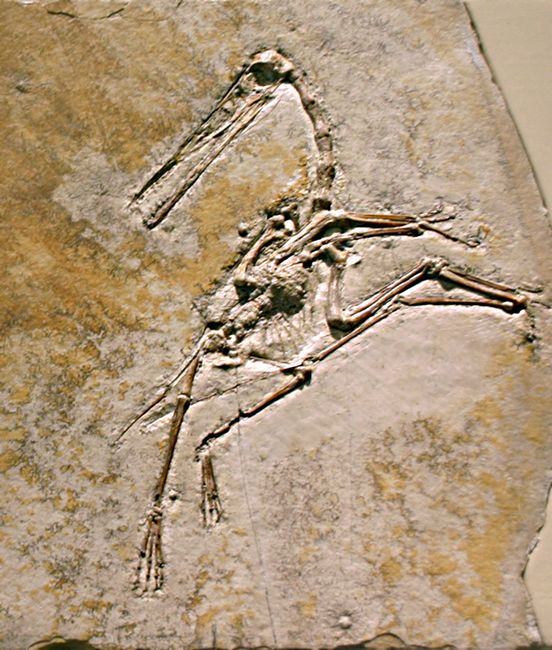Athena Review Image Archive ™
Pterodactylus antiquus, the winged Jurassic reptile

Pterodactyus antiquus (AMNH 1942, photo Athena Review )
Pterodactylus ("winged
finger") was a Late Jurassic flying reptile dating from 151-148 mya. It
was first found as the cast of a juvenile in the fine-grained Solnhlgen
limestone in Bavaria, Germany by the Italian scientist Cosimo
Alessandro Collini in 1784. Collini, however, could not identify the
type of animal. The first identification that Pterodactylus used its long fourth finger to support a wing membrane was made by German scientist Johann Hermann in 1800. The name Pterodactylus, coined by Cuvier in 1812, referred to how the wing is attached to a single greatly extended finger.
The
pterodactyls are now known to be part of an order of flying reptiles
called Pterosaurs. Their wings were formed by a skin and muscle
membrane stretching from the elongated fourth finger to the hind limbs.
Other Pterosaurs included Pteranodon (first found by Williston) and Quetzalcoatlus, both living during the Late Cretaceous (100-65 mya). While Pterodactylus was relatively small, some pterosaurs had huge wingspans of up to 12 meters (Witton 2010).
A number of fossils of Pterodactylus have been found, including several in England by Owen (1859), and in North America by Cope (1872), as well as others in Africa and Europe. Most have now been placed in the single species P. antiquus. Pterodactylus was a carnivore that probably ate fish as well as other small animals. The skulls of adults were long and thin, with about 90 narrow, conical teeth, with the jaws having a distinct avian, beak-like appearance. The image shows an adult P. antiquus in the collection of the American Museum of Natural History (AMNH), with traces of shoulder and breast muscles preserved in the fossil impression.
References:
Collini, C A. 1784. Sur quelques Zoolithes du Cabinet d'Histoire naturelle de S. A. S. E. Palatine & de Bavière, à Mannheim . Acta Theodoro-Palatinae Mannheim . 5 Physicum: 58–103.
Cope, E. D. 1872. On two new Ornithosaurians from Kansas. Proceedings of the American Philosophical Society. 12 (88): 420–422.
Cuvier, G. 1812. Article V – Sur le squelette fossile d'un reptile volant des environs d'Aichstedt, que quelques naturalistes ont pris pour un oiseau et dont nous formons un genre de sauriens, sous le nom de ptéro-dactyle. Recherches sur les ossemens fossiles de quadrupèdes. Tome 4. Paris, Deterville.
Owen, R. 1859. Monograph on the fossil Reptilia of the Cretaceous formations. Supplement no. I. Palaeontographical Society, London, p. 19.
Witton, M.P 2010. Pteranodon and beyond: The history of giant pterosaurs from 1870 onwards. Geological Society of London Special Publications. 343..
Copyright © 1996-2020 Rust Family Foundation (All Rights Reserved).